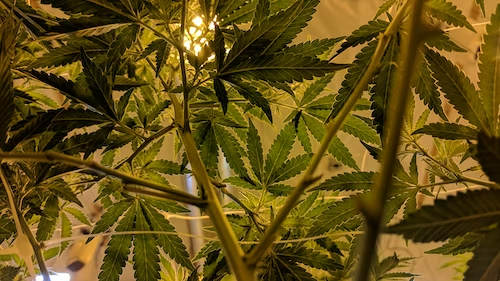Pinene, a prevalent terpene known for its distinctive aroma and potential health benefits, plays a vital role in the realm of aromatics and wellness.
In this article, we delve into the frequently asked questions about pinene, its multifaceted effects, and its presence in various botanical sources. From its molecular structure to its potential therapeutic applications, we'll uncover the key aspects of this intriguing compound.
What is the Pinene Terpene?
Pinene is one of over 200 terpenes found in cannabis, contributing to the entourage effect and the unique properties of different strains. As a bicyclic monoterpene, its chemical structure consists of two fused hydrocarbon rings, classified as alpha-pinene and beta-pinene.
This terpene holds promise for addressing various health concerns like inflammation, cancer, and respiratory issues like asthma. It possesses the unique ability to induce both relaxation and energy and provides that unmistakable pine scent while also deterring insects in nature.
Let's start by unveiling the essence of pinene.
Imagine a world where the fragrance of coniferous trees dances through the air. This aromatic treasure is not confined to forests; it's present in herbs, spices, and a plethora of botanical sources. Think of it as nature's aromatic signature that has the power to transport you to the heart of a serene pine forest.

What Does Pinene Do?
The pinene terpene, commonly found in pine trees, cannabis, and other plants, offers a range of potential health benefits. It exhibits anti-inflammatory properties, making it valuable in reducing inflammation throughout the body. Additionally, pinene shows promise as an antimicrobial agent, potentially aiding in controlling harmful bacteria within the body.
Pinene has been studied for its potential to support respiratory health. It acts as a bronchodilator and could potentially help with conditions like bronchitis and asthma.
Furthermore, pinene may have anxiety-reducing effects, as suggested by preliminary studies. It also shows neuroprotective potential, indicating it could play a role in combating cognitive disorders like Alzheimer's Disease.
Overall, pinene's versatile attributes make it a significant and multifaceted compound with potential applications in both natural and medicinal contexts.
Which Strains Contain the Most Pinene?
There are many cannabis strains high in pinene:
|
Strain |
Strain Type |
Aromas & Flavors |
|---|---|---|
|
Jack Herer |
Sativa-dominant hybrid |
Piney, earthy aroma with uplifting effects |
|
Dutch Treat |
Hybrid |
Sweet pine scent, energetic buzz |
|
Romulan |
Indica-dominant hybrid |
Pine smell with relaxing body high |
|
Blue Dream |
Sativa-dominant hybrid |
Sweet fruity aroma with pine undertones, mild cerebral buzz |
|
Island Sweet Skunk |
Sativa hybrid |
Tropical fruit and pine smell, energetic high |
|
Strawberry Cough |
Sativa hybrid |
Sweet strawberry aroma with pine notes, heady effects |
|
OG Kush |
Hybrid |
Woodsy, piney scent, relaxing body high |
Pinene's Roles and Effects:
As we delve deeper, the multifaceted roles of pinene come to light. Beyond being a mere aroma, pinene has a knack for influencing both the mind and the body.
Some claim that pinene possesses the ability to enhance alertness and memory, almost like a whiff of crisp mountain air that wakes up your senses. But its effects don't stop there – pinene might have potential therapeutic contributions, making it more than just a scent; it's a potential ally in holistic wellness.
This versatile terpene is the ultimate mood elevator that keeps you zen yet focused. Its ability to target inflammation also makes it therapeutic for a wide range of health conditions.
Beyond its woodsy fragrance, the pinene terpene offers some intriguing effects and wellness benefits:
-
Boosts alertness and concentration
-
Elevates mood and counters anxiety
-
Anti-inflammatory and bronchodilator properties to support respiratory health
-
Powerful antioxidant and antimicrobial actions
-
Enhances memory, mental focus, and cognitive function
-
Balances effects of THC, reducing short-term memory impairment
Pinene in Nature and Cannabis
Take a stroll through a pine forest and your senses will be met with the refreshing aroma of pinene. This dynamic terpene is found abundantly throughout nature, lending its piney essence to conifers, rosemary, basil, and cannabis alike. Let's explore the fascinating roles it plays across the plant kingdom.
In the natural world, pinene helps plants deter insect infestations and plant-grazing animals. It also gives vegetation in pine forests, citrus groves, and lush herb gardens their characteristic scents. Humans have harnessed Pinene's aromatic qualities for uses like fragrances and cleansing agents.
When it comes to cannabis, pinene brings its own magic to various strains. It provides an unmistakable pine overtone that balances the dank, earthy notes of other terpenes. Strains with substantial pinene include Blue Dream, Jack Herer, and Super Lemon Haze.
Pinene also initiates synergistic effects with other cannabis compounds. It interacts to elevate moods and works in harmony with linalool for deeper relaxation. This dynamic combination of scents and effects is called the entourage effect.
For medical marijuana patients, the anti-inflammatory and antimicrobial actions of pinene may help relieve symptoms related to pain, infections, and respiratory issues like asthma.

What is the Pinene Terpene in Weed?
Pinene is a natural organic compound found in cannabis plants that contributes to the plant's aroma, flavor, and potential effects. This terpene takes its name from its prevalence in pine trees and shares its distinct piney fragrance.
In the context of cannabis, pinene plays a significant role in shaping the overall character of a strain. Its aroma can range from a refreshing pine scent to a more herbal, earthy fragrance.
Beyond just scent, pinene has been associated with potential health benefits. It possesses anti-inflammatory properties that could aid in mitigating inflammation in the body.
As one of the most common terpenes found not only in cannabis but also in the natural world, pinene's presence in weed offers more than just a pleasing aroma.
Its potential health benefits and distinctive attributes add to the complex profile of each strain, highlighting the intricate interplay between terpenes and cannabinoids in shaping the overall cannabis experience.
Is Pinene Polar or Non-Polar?
Pinene is a non-polar molecule, meaning its distribution of electrons is even and symmetrical, resulting in a lack of distinct positive and negative charges across the molecule.
In the case of pinene, its structure consists of carbon and hydrogen atoms bonded together in a way that leads to an overall balanced distribution of charge. This absence of a significant charge difference between atoms makes pinene nonpolar.
The non-polar nature of pinene has implications for its interactions with other substances. Non-polar molecules tend to interact more readily with other non-polar substances and are less soluble in polar solvents like water.
This characteristic plays a role in how pinene is experienced, particularly in relation to its aroma and flavor. As a nonpolar compound, pinene's distinct piney scent is more easily dispersed in the air, contributing to its recognizable fragrance in pine trees and various plant species, including cannabis.
Understanding the polarity of pinene and its interaction with other molecules can provide insights into its behavior and its role in various applications, from its contribution to the aroma of plants to its potential effects in medicinal contexts.
Is Pinene Safe?
Recent research has highlighted the potential use of terpenes, particularly pinene and linalool, as terpene-based medicines for brain health.
While the focus has long been on major cannabinoids like CBD and Δ9-THC, attention has turned to the cannabis plant's diverse compounds, including terpenes responsible for scent and flavor. The study reviewed indicates that pinene and linalool show promise in preclinical studies with their anti-oxidant, anti-inflammatory, and neuroprotective properties.
However, comprehensive clinical trials are lacking, and further research is needed to explore their potential as treatments for conditions such as stroke, pain, cognitive issues, insomnia, anxiety, and depression.
Both pinene and linalool interact with neurotransmitter, inflammatory, and neurotrophic signals, demonstrating psychoactivity without causing intoxication.
Optimizing the chemical composition of cannabis strains to yield therapeutic levels of these terpenes, combined with cannabinoids like CBD, could offer novel treatments for neurological and psychiatric disorders.
Yet, the current research emphasizes the necessity of more comprehensive studies to fully understand the safety, efficacy, and mechanisms of action of pinene and linalool for brain health.

Health Benefits of Pinene
Beyond a pleasant pine scent, emerging research suggests pinene offers profound wellness benefits. Let’s explore the top healing properties of this aromatic terpene.
Pinene’s broncho-dilating effects open airways and offer smooth, clear hits for cannabis users. The perfect pick-me-up in times of respiratory congestion! As an anti-inflammatory, pinene may help reduce swelling and fluid buildup in conditions like asthma, joint pain, infections, and autoimmune disorders.
By enhancing mental acuity and memory, pinene provides cognitive pinene benefits for both healthy and cognitively impaired individuals. Stay sharp as a pinene!
Anxiolytic (anti-anxiety) properties lend to Pinene’s relaxing yet uplifting effects, perfect for countering mood disorders. While research continues, pinene’s current medical applications are promising. Nature creates, science investigates, and humans heal.
Some benefits of the pinene terpene include:
-
Broncho-dilating effects for improved airflow.
-
Anti-inflammatory properties to reduce swelling.
-
Antimicrobial actions for immune support.
-
Abundant antioxidants for cellular protection.
-
Enhanced mental acuity and memory.
-
Anxiolytic (anti-anxiety) effects.
-
Potential applications in various medical contexts.
Does Pinene Cause Anxiety?
The potential impact of pinene on anxiety is a topic of exploration within the realm of terpene research. While it is not inherently known to cause anxiety, its complex effects on mood and anxiety can vary from person to person.
Pinene's potential to influence anxiety is influenced by individual factors such as sensitivity, dosage, and overall health.
While some users may experience a sense of relaxation and reduced anxiety due to Pinene's properties, others might not notice significant changes or could even experience heightened anxiety under certain circumstances. The interplay between pinene and other compounds also contributes to its effects.
Understanding the potential impact of pinene on anxiety requires a comprehensive and individualized perspective. While some individuals may find pinene to have a calming effect, it's important to recognize that responses are diverse and context-dependent.
Careful self-observation and consideration of personal responses are crucial when assessing how pinene affects anxiety.
Pinene and Respiratory Health
Few feelings compare to inhaling crisp, pine-scented air that instantly revitalizes your respiratory system. These are the holistic healing effects that Pinene offers for respiratory health. Let’s dive into the science behind it.
Research indicates pinene acts as a natural bronchodilator, relaxing smooth muscle tissue in bronchial airways. This increases airflow and oxygen circulation throughout the lungs. By reducing inflammation in the respiratory tract, pinene also helps clear excess mucus and open airways.
Think of it like a breath of fresh air that awakens your lungs. The antimicrobial effects of pinene further benefit respiratory health by combatting bacterial, viral, and fungal infections trying to take hold.
Studies show pinene counteracts lung inflammation from cigarette smoke, making cannabis an appealing medicinal option for smokers. For medical marijuana patients, pinene-rich strains can potentially provide fast-acting, natural relief for conditions like asthma, COPD, bronchitis, and upper respiratory infections.
Aromatic Impact: How Pinene Influences the Senses
Close your eyes. Inhale slowly, taking in the crisp, verdant aroma of pine wafting through the breeze. This is the aromatic enchantment of Pinene activating your senses. Let’s explore how it achieves this.
Research shows pinene quickly crosses the blood-brain barrier where it interacts with neurotransmitters involved in vigilance, sensory perception, and emotional processing. Specific receptors pinene binds to help induce alertness and counter cognitive fatigue - perfect for an early morning wake and bake!
Terpenes like pinene also influence the signaling of olfactory receptors in the nose that identify scents. This helps refresh and restore the smell sense. Through limbic system pathways, pinene’s aroma taps into memories and emotions linked to pine scents, bringing a nostalgic natural calm.
Subtle dilating of bronchioles enhances airflow, allowing more pinene molecules to reach sensory receptors in the lungs. So next time you get a whiff of that piney cannabis, envision pinene molecules dancing through receptors, neurons, and membranes to brighten your senses.
Molecular Structure: Decoding Pinene's Blueprint:
Pinene structure refreshing pine fragrance and far-reaching health effects originate at the molecular level. Let’s crack the code of this terpene’s structural blueprint. The chemical formula for pinene is C10H16. It consists of two conjoined hydrocarbon rings with a non-polar core and a four-carbon polar tail.
Based on slight variances in the positioning of its carbon double bonds, pinene exists as one of two isomers: alpha-pinene or beta-pinene. Alpha-pinene is more abundant in nature. It features a cyclic bond between carbons one and six on its hydrocarbon skeleton. Beta-pinene has a bond between carbons one and four instead.
Despite minor structural differences, both pinene isomers convey the characteristic pine scent. But alpha-pinene has shown more potent antimicrobial effects. The small reactive tail on pinene interfaces with receptors and alters signaling cascades that influence physiological processes.
Tiny structural tweaks to pinene’s molecular architecture impact its aroma, actions, and interactions. This illustrates the importance of nature’s intricate molecular orchestrations.
How Many Hydrogens Are in Pinene?
The \pinene terpine is a natural compound found in various plants, including Teucrium montanum and Xylopia aromatica, possesses a molecular formula of C10H16. Pinene structure this composition signifies the presence of 16 hydrogen atoms within its structure.
Known for its distinctive turpentine odor, alpha-pinene is a clear colorless liquid with diverse applications. It finds use as a solvent and holds the potential for various roles, including as a plant metabolite.
With a molecular weight of 136.23 g/mol, alpha-pinene contributes to the aromatic and chemical complexity of the botanical world. Its chemical structure, consisting of a bicyclo[3.1.1]hept-2-ene core with methyl substitutions at positions 2, 6, and 6 respectively, underlines its unique characteristics.
This compound's prevalence in nature, combined with its hydrogen-rich composition, contributes to its relevance in botanical and chemical contexts.

Pinene Handling and Considerations
When handling pinene, it's important to be aware of its properties and potential toxicity. Alpha-pinene, a common form of pinene, appears as a clear colorless liquid with a distinctive turpentine odor. This compound has a flash point of 91°F, and its vapors are heavier than air.
While it's less dense than water and insoluble in it, precautions should still be taken when dealing with pinene to avoid potential hazards. Proper ventilation and protective equipment are recommended to ensure safe handling and prevent any adverse effects that may arise from exposure.
Is Pinene Toxic?
Pinene is generally considered safe when handled and used appropriately. However, like any chemical compound, it can have adverse effects if not used properly. The turpentine-like odor it emits, especially in concentrated forms, can cause irritation to the eyes, nose, and throat.
Inhaling high concentrations of pinene vapors could lead to respiratory discomfort. While pinene is not typically considered highly toxic, it's essential to handle it with care, particularly in enclosed spaces without proper ventilation.
Is Pinene Flammable?
Yes, pinene is flammable. This means that the compound can ignite and burn under certain conditions. Its flash point of 91°F indicates that it can release flammable vapors at relatively low temperatures.
As a result, caution should be exercised when working with pinene, especially in environments where open flames, sparks, or high temperatures are present. Proper storage away from potential ignition sources and adherence to safety guidelines are crucial to prevent accidents related to its flammable nature.
Final (Pine-Scented) Thoughts
Pinene, a versatile terpene with its distinct aromatic signature and potential health benefits, continues to intrigue researchers and wellness enthusiasts alike. Its prevalence in a variety of plants and its potential effects on cognition and respiratory well-being make it a subject of significant interest.
As scientific exploration uncovers more about pinene's effects and applications, its potential to enrich sensory experiences and contribute to holistic well-being becomes increasingly apparent.











